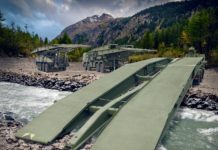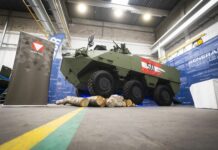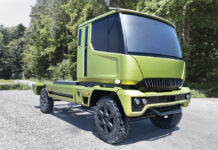At the Military Institute of Armoured and Automotive Technology in Sulejowek, near Warsaw General Dynamics European Land Systems and Griffin Group Defence presented a number of mobile bridge systems offered for the armed forces of Poland and several other countries in the Central and Eastern Europe (CEE) region.
According to Rolf Wenning, Senior Manager, International Business & Services Bridge Systems Europe, GDELS, the company is aware of the broad requirement for mobile bridge systems all across the CEE region.
GDELS is particularly focused on countries such as Poland, Slovakia, Czech Republic and Romania, which lack modern and proven mobile bridge systems, capable of providing a sustained transport capability for heavy armoured vehicles across water and land obstacles.
The marketing campaign for GDELS bridge systems seems to come at the right time, as NATO has already identified the need to improve troops manoeuvrability throughout the CEE region as part of its enhanced forward presence initiative on the Alliance’s Eastern flank.
Over the past several years NATO organised a series of exercises during which a number of troops and various military equipment, mostly from the U.S. Army contingent in Germany, were transported via Poland and other CEE countries to the Baltic States as part of a show of force against the background of the deterioration of relations between the West and Russia.
During these exercises a number of deficiencies regarding road and bridge infrastructure were identified, which complicated and delayed troop movements or even led to a series of accidents.
Among sthe ystems presented during the seminar at WITPIS was the VIPER modular, lightweight folding bridge integrated with the Jelcz 442 two-axis truck manufactured by the local Jelcz company, a member of the Polish Armaments Group (Polska Grupa Zbrojeniowa, PGZ) holding.
VIPER is made of aluminium modules and is available in lengths of 4, 6 and 8 metres. It is capable to provide river/gap crossing capability for land platforms of different wheelbase, and is designed for maximum loads of up to MLC 40.
The system is equipped with an adaptable launcher, which can be integrated with a wide range of land platforms, such as transport, tactical and specialised vehicles or trailers.
Another system presented was the MAMBA lightweight infantry bridge. It is designed to support operations of infantry and airborne troops during crossing of dry and wet gaps with a maximum width of 30 m. The system can be extended by attaching additional bridge modules.
MAMBA can be used for movement of troops, evacuation of injured soldiers as well as transport of supplies and other auxiliary equipment across harsh terrain.
Michal Jarocki











